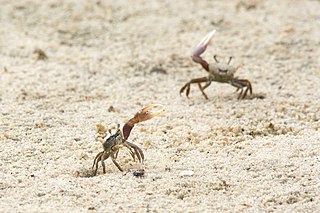
The fiddler crab or calling crab can be one of the hundred species of semiterrestrial marine crabs in the family Ocypodidae. These crabs are well known for their extreme sexual dimorphism, where the male crabs have a major claw significantly larger than their minor claw, whilst females claws are both the same size. The name fiddler crab comes from the appearance of their small and large claw together, looking similar to a fiddle.

The Ocypodidae are a family of semiterrestrial crabs that includes the ghost crabs and fiddler crabs. They are found on tropical and temperate shorelines around the world.

Leptuca pugilator, the sand fiddler crab, Atlantic sand fiddler crab, or Calico fiddler, is a species of fiddler crab that is found from Massachusetts to the Gulf of Mexico. It lives in burrows in coastal and estuarine mud-flats, and can be extremely abundant. It can be differentiated from the morphologically similar Minuca pugnax and Minuca minax by the smoothness of the inside of its claws. One claw is larger than the other, and can be much larger than the crab's body, at up to 41 mm (1.6 in) long.

Gelasimus vocans is a species of fiddler crab. It is found across the Indo-Pacific from the Red Sea, Zanzibar and Madagascar to Indonesia and the central Pacific Ocean. It lives in burrows up to 50 centimetres (20 in) deep. Several forms of G. vocans have been recognised, with their authors often granting them the taxonomic rank of full species or subspecies.

Austruca annulipes is a species of fiddler crab found along the coastline from South Africa to Somalia, Madagascar, India, China, Indonesia, Malaysia, and the Philippines.

Leptuca crenulata, commonly known as the Mexican fiddler crab, is a species of American broad-front fiddler crab in the family Ocypodidae.

Leptuca thayeri, known generally as the Atlantic mangrove fiddler crab or mangrove fiddler, is a species of true crab in the family Ocypodidae. It is distributed all across the Western Atlantic.

Leptuca is a genus of fiddler crabs belonging to the family Ocypodidae.

Leptuca panacea, commonly known as the Gulf sand fiddler crab or the Panacea sand fiddler, is a species of fiddler crab native to coastal habitats along the Gulf of Mexico from northwestern Florida to Mexico.
Leptuca speciosa, commonly known as the brilliant fiddler crab or the longfinger fiddler crab, is a species of fiddler crab native to the southern United States, Mexico, and the Caribbean.
Leptuca subcylindrica, commonly known as the Laguna Madre fiddler crab or the puffed fiddler crab, is a sparsely-studied species of fiddler crab native to southern Texas and northeastern Mexico in the Gulf of Mexico.
Leptuca leptodactyla, commonly known as the thin-fingered fiddler crab or the western Atlantic fiddler crab, is a species of fiddler crab native to the western Atlantic coast of the Americas.
Leptuca cumulanta, commonly known as the heaping fiddler crab or the mangrove fiddler crab, is a species of fiddler crab native to tropical and subtropical areas of the western Atlantic.

Leptuca uruguayensis, commonly known as the Uruguayan fiddler crab or the southwestern Atlantic fiddler crab, is a species of fiddler crab native to temperate and subtropical areas of the southeastern coast of South America.
Leptuca beebei, commonly known as Beebe's fiddler crab, is a species of fiddler crab native to the Pacific coasts of Central and South America, from El Salvador to northern Peru.
Leptuca batuenta, commonly known as the beating fiddler crab, is a species of fiddler crab native to the tropical eastern Pacific, from El Salvador to northern Peru.
Leptuca saltitanta, commonly known as the energetic fiddler crab, is a species of fiddler crab native to the eastern Pacific coasts, from El Salvador in Central America to Colombia in South America.
Leptuca helleri, commonly known as Heller's fiddler crab, is a species of fiddler crab endemic to the Galapagos Islands in the eastern Pacific Ocean.
Leptuca deichmanni, commonly known as Deichmann's fiddler crab, is a species of fiddler crab native to the eastern Pacific coast of Central America, in Costa Rica and Panama.
Leptuca musica, commonly known as the musical fiddler crab, is a species of fiddler crab native to Baja California and the Gulf of California in Mexico.









